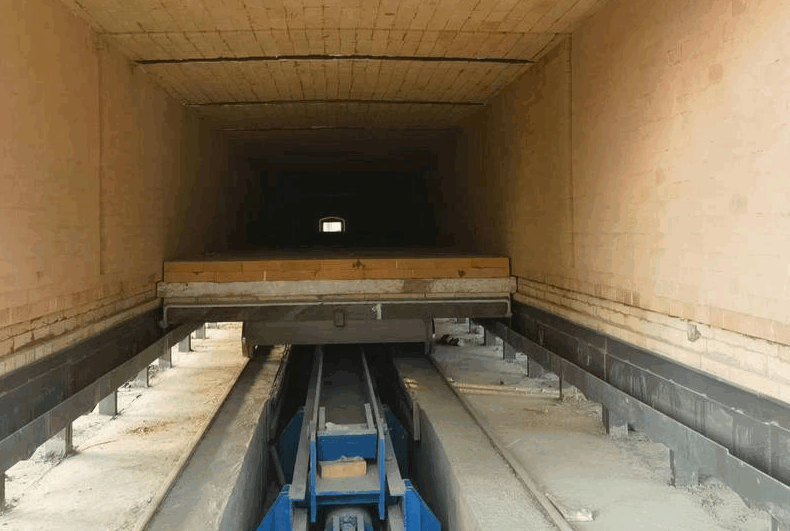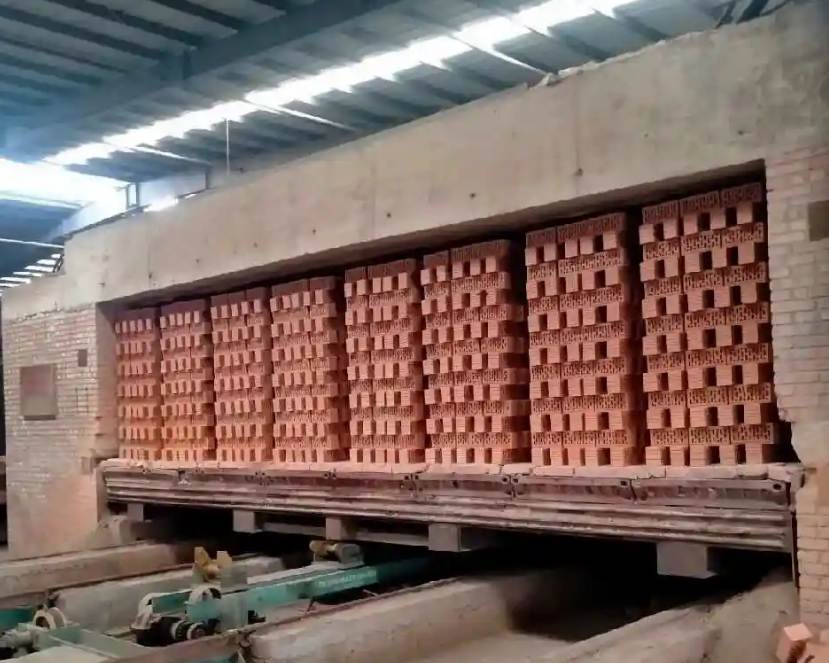he principles, structure, and basic operation of tunnel kilns were covered in the previous session. This session will focus on the operation and troubleshooting methods for using tunnel kilns to fire clay building bricks. A coal-fired kiln will be used as an example.
I. Differences
Clay bricks are made from soil with low mineral content, high plasticity, and adhesive properties. Water is difficult to remove from this material, making the brick blanks harder to dry compared to shale bricks. They also have lower strength. Therefore, the tunnel kilns used to fire clay bricks are slightly different. The stacking height is slightly lower, and the preheating zone is slightly longer (approximately 30-40% of the total length). Since the moisture content of wet brick blanks is approximately 13-20%, it is best to use a tunnel kiln with separate drying and sintering sections.
II. Preparation for Firing Operations:
Clay brick blanks have relatively low strength and slightly higher moisture content, making them difficult to dry. Therefore, special attention should be paid during stacking. As the saying goes, “Three parts firing, seven parts stacking.” When stacking, first develop a stacking plan and arrange the bricks reasonably; place them in a grid pattern with denser edges and sparser centers. If the bricks are not stacked properly, it can lead to moisture collapse, pile collapse, and poor airflow, making the firing process more difficult and causing abnormal conditions such as front fire not spreading, rear fire not maintaining, top fire being too fast, bottom fire being too slow (fire not reaching the bottom), and middle fire being too fast while sides are too slow (unable to progress uniformly).
Tunnel Kiln Temperature Curve Pre-setting: Based on the functions of each section of the kiln, first pre-set the zero pressure point. The preheating zone is under negative pressure, while the firing zone is under positive pressure. First, set the zero-pressure point temperature, then pre-set the temperatures for each car position, plot the temperature curve diagram, and install temperature sensors at critical locations. The preheating zone (approximately positions 0-12), firing zone (positions 12-22), and remaining cooling zone can all operate according to the pre-set temperatures during the process.
III. Key Points for Firing Operations
Ignition Sequence: First, start the main blower (adjust airflow to 30–50%). Ignite the wood and coal on the kiln car, controlling the temperature rise rate to approximately 1°C per minute, and slowly increasing the temperature to 200°C. Once the kiln temperature exceeds 200°C, slightly increase the airflow to accelerate the temperature rise rate and reach the normal firing temperature.
Firing Operations: Strictly monitor temperatures at all locations according to the temperature curve. The firing speed for clay bricks is 3–5 meters per hour, and for shale bricks, 4–6 meters per hour. Different raw materials, stacking methods, and fuel mixture ratios will all affect the firing speed. According to the set firing cycle (e.g., 55 minutes per car), advance the kiln car uniformly, and act quickly when loading the car to minimize kiln door opening time. Maintain stable kiln pressure as much as possible. (Preheating zone: negative pressure -10 to -50 Pa; firing zone: slight positive pressure 10-20 Pa). For normal pressure adjustment, with the air damper properly adjusted, only adjust the fan speed to control the kiln pressure.
Temperature control: Slowly increase the temperature in the preheating zone by approximately 50-80°C per meter to prevent rapid heating and cracking of the bricks. In the firing zone, pay attention to the firing duration after reaching the target temperature to avoid incomplete firing inside the bricks. If temperature changes occur and the high-temperature constant-temperature duration is insufficient, coal can be added through the kiln top. Control the temperature difference within 10°C. In the cooling zone, adjust the fan speed of the cooling fan to control air pressure and airflow based on the temperature of the finished bricks exiting the kiln, to prevent rapid cooling from causing high-temperature-fired finished bricks to crack.
Kiln exit inspection: Inspect the appearance of finished bricks exiting the kiln. They should have uniform color. Underfired bricks (low temperature or insufficient firing time at high temperature, resulting in light color) can be returned to the kiln for re-firing. Overfired bricks (high temperature causing melting and deformation) should be removed and discarded. Qualified finished bricks have uniform color and produce a crisp sound when tapped, and can be sent to the unloading area for packaging and transportation.
IV. Typical Faults and Troubleshooting Methods for Tunnel Kiln Operations
Firing zone temperature fails to rise: The internal combustion bricks were not blended according to their heat output, and the fuel has a low calorific value. Solution for insufficient blending: Adjust the blending ratio to exceed the required amount slightly. Firebox blockage (ash buildup, collapsed brick bodies) causes oxygen deficiency, resulting in an insufficient rise in temperature. Troubleshooting method: Clean the fire channel, clear the flue, and remove collapsed green bricks.
Kiln car stalling during operation: Track deformation (caused by thermal expansion and contraction). Troubleshooting method: Measure the track levelness and spacing (tolerance ≤ 2 mm), and correct or replace the track. Kiln car wheels locking up: Troubleshooting method: After unloading finished bricks each time, inspect the wheels and apply high-temperature resistant lubricating oil. Surface efflorescence on finished bricks (white frost): “Excessively high sulfur content in the brick body leads to the formation of sulfate crystals. Troubleshooting method: Adjust the raw material ratio and incorporate low-sulfur raw materials. Excessively high sulfur content in coal. Troubleshooting method: Increase exhaust gas volume at the preheating zone when the temperature reaches approximately 600°C to vent the released sulfur vapor.”
V. Maintenance and Inspection
Daily Inspection: Check whether the kiln door opens and closes normally, whether the sealing meets requirements, and whether the kiln car is damaged after unloading bricks. Inspect the kiln car wheels to ensure they operate normally, apply high-temperature lubricating oil to each wheel, and check whether the temperature monitoring lines are damaged, connections are secure, and functions are normal.
Weekly Maintenance: Add lubricating oil to the fan, check if the belt tension is appropriate, and ensure all bolts are securely fastened. Add lubricating oil to the transfer car and top car machine. Inspect all components for normal operation. Track Inspection: Due to significant temperature differences in the kiln, thermal expansion and contraction may cause track loosening. Check if the track heads and gaps between the transfer cars are normal.
Monthly inspection: Inspect the kiln body for cracks, check the condition of the refractory bricks and kiln walls, and calibrate the temperature detection equipment (error <5°C).
Quarterly maintenance: Remove debris from the kiln passage, clean the flue and air ducts, inspect the sealing condition of expansion joints at all locations, check the kiln roof and kiln body for defects, and inspect the circulation equipment and temperature control system, etc.
VI. Environmental Protection and Safety
Tunnel kilns are thermal engineering furnaces, and especially for coal-fired tunnel kilns, flue gas treatment must be equipped with wet electrostatic precipitators for desulfurization and denitrification to ensure that the emitted flue gas meets emission standards.
Waste heat utilization: Hot air from the cooling zone is conveyed through pipes into the preheating zone or drying section to dry wet brick blanks. Waste heat utilization can reduce energy consumption by approximately 20%.
Safety Production: Gas-fired tunnel kilns must be equipped with gas detectors to prevent explosions. Coal-fired tunnel kilns must be fitted with carbon monoxide detectors, especially during kiln ignition to prevent explosions and poisoning. Adhering to operating procedures is essential for ensuring safe production.
Post time: Jun-16-2025


